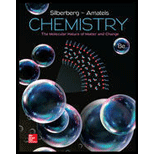
Concept explainers
(a)
Interpretation:
The name, atomic symbol and group number and period of the element with Z value 14 is to be determined. Also whether the element is a metal, non-metal or a metalloid is to be determined.
Concept introduction:
A periodic table is an arrangement of elements based on their
(b)
Interpretation:
The name, atomic symbol and group number and period of the element with Z value 55 is to be determined. Also whether the element is a metal, non-metal or a metalloid is to be determined.
Concept introduction:
A periodic table is an arrangement of elements based on their atomic number, properties, and electronic configuration. The table is arranged into groups and periods. The elements which are metallic in nature, occupy the large lower-left portion of the table. The non-metals occupy the small upper-right portion of the table. Metalloids like along the staircase line. Elements which appear in the same group have similar behaviour.
(c)
Interpretation:
The name, atomic symbol and group number and period of the element with Z value 54 is to be determined. Also whether the element is a metal, non-metal or a metalloid is to be determined.
Concept introduction:
A periodic table is an arrangement of elements based on their atomic number, properties, and electronic configuration. The table is arranged into groups and periods. The elements which are metallic in nature, occupy the large lower-left portion of the table. The non-metals occupy the small upper-right portion of the table. Metalloids like along the staircase line. Elements which appear in the same group have similar behaviour.
Want to see the full answer?
Check out a sample textbook solution
Chapter 2 Solutions
Chemistry: The Molecular Nature of Matter and Change
 ChemistryChemistryISBN:9781305957404Author:Steven S. Zumdahl, Susan A. Zumdahl, Donald J. DeCostePublisher:Cengage Learning
ChemistryChemistryISBN:9781305957404Author:Steven S. Zumdahl, Susan A. Zumdahl, Donald J. DeCostePublisher:Cengage Learning ChemistryChemistryISBN:9781259911156Author:Raymond Chang Dr., Jason Overby ProfessorPublisher:McGraw-Hill Education
ChemistryChemistryISBN:9781259911156Author:Raymond Chang Dr., Jason Overby ProfessorPublisher:McGraw-Hill Education Principles of Instrumental AnalysisChemistryISBN:9781305577213Author:Douglas A. Skoog, F. James Holler, Stanley R. CrouchPublisher:Cengage Learning
Principles of Instrumental AnalysisChemistryISBN:9781305577213Author:Douglas A. Skoog, F. James Holler, Stanley R. CrouchPublisher:Cengage Learning Organic ChemistryChemistryISBN:9780078021558Author:Janice Gorzynski Smith Dr.Publisher:McGraw-Hill Education
Organic ChemistryChemistryISBN:9780078021558Author:Janice Gorzynski Smith Dr.Publisher:McGraw-Hill Education Chemistry: Principles and ReactionsChemistryISBN:9781305079373Author:William L. Masterton, Cecile N. HurleyPublisher:Cengage Learning
Chemistry: Principles and ReactionsChemistryISBN:9781305079373Author:William L. Masterton, Cecile N. HurleyPublisher:Cengage Learning Elementary Principles of Chemical Processes, Bind...ChemistryISBN:9781118431221Author:Richard M. Felder, Ronald W. Rousseau, Lisa G. BullardPublisher:WILEY
Elementary Principles of Chemical Processes, Bind...ChemistryISBN:9781118431221Author:Richard M. Felder, Ronald W. Rousseau, Lisa G. BullardPublisher:WILEY





